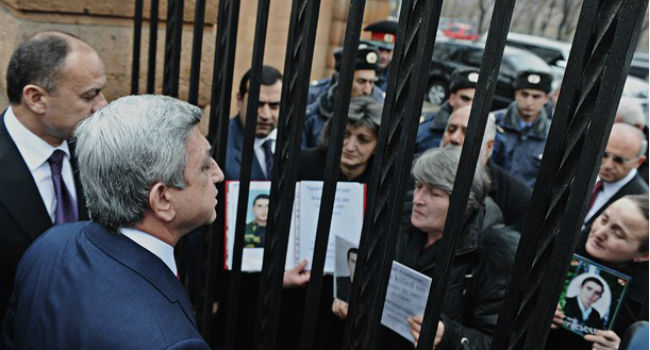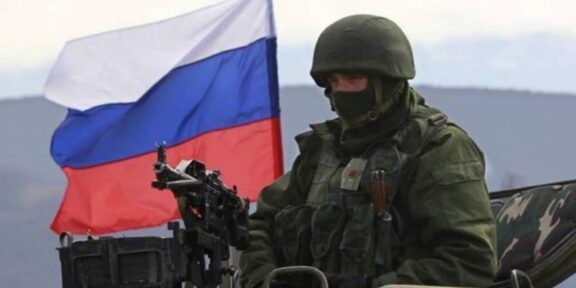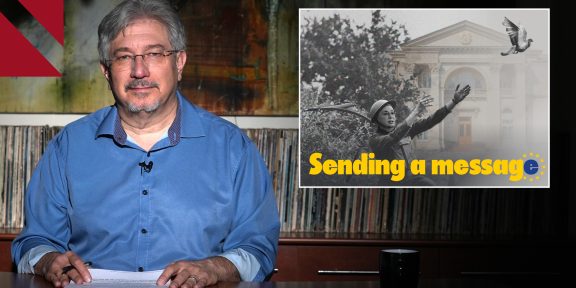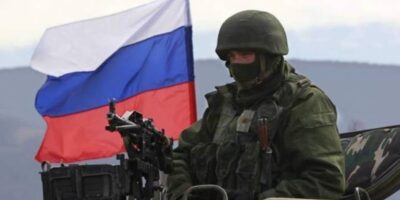During the weeks before the Armenian presidential elections of February 18, 2013, the Brussels-based association European Friends of Armenia (EuFoA) published two polls which gave Serzh Sargsyan a large win in what was presented as a free and democratic election. But a closer look reveals that this association, which had a 314,116 Euro budget in 2011 is in fact led by a former (?) employee of a huge American communication and lobbying company, Burson-Marsteller. What is more worrying regarding the righteousness of this “association’s” work is that Burson-Marsteller has worked directly for Serzh Sargsyans’s public relations in the US between 2006 and 2007. Let us take a closer look at what smells like a government scandal.
A title as pleasant as “European Friends of Armenia” would a priori inspire nothing but trust. However, a closer look at a series of elements calls for caution.
What does this association do?
The French version of the home page of EuFoA’s website claims: “We work actively to connect “decision-makers” from all sides and inform them of the challenges and successes in Euro-Armenian relations. This website aims to provide documentation regarding our work, as well as key information about the evolution of Euro-Armenian relations.
Vast program. But more specifically? EuFoA is based in Brussels and spends most of its budget and resources ordering electoral polls from the TNS opinion institute. For the last Armenian presidential election, EuFoA ordered two polls presented on the French version of their website as follows: “January 25, 2013: Armenians take elections very seriously, despite the outgoing president’s clear lead”; “February 9, 2013: Voters increasingly confident regarding elections, as the race enters its final phase – Hovannisian gains ground but Sargsyan still seems well on track to winning the first round.”
To summarize: the election is honest and Serzh Sargsyan is on his way to win it from the very first round. Reading the reports and polls of EuFoA will only strengthen this impression, the latter being remarkably well presented through an abundance of color diagrams which will make you dizzy. And for the skeptical readers, they will have been reassured by reading the first chapter cleverly entitled “Methodology and Poll Quality Check”. In other words, read and believe!
Who are the founders of EuFoA?
According to the statutes of EuFoA, published in the Belgian Official Journal/Bulletin of Acts available online, EuFoA has a status of International Non-Profit Organization. The four founders of EuFoA are Paruyr Amirjanyan, Tevan Poghosyan, Roberta Bonazzi and Michael Kambeck. The first two are Armenian nationals living in Armenia. Paruyr Amirjanyan is a member of a think tank called International Center for Human Development (ICHD). ICHD seems to have significant financial means and has been engaged, for at least 10 years, in “Armenian Turkish Rapprochement.” As to Tevan Poghosyan, he has been the executive director of ICHD from 2000 to 2012, as well as Executive Director of the Armenian Atlantic Association from 2001 to 2012, an association which argues in favor of Armenia-NATO rapprochement. It should be noted that Tevan Poghosyan is MP of Raffi Hovannisian’s Heritage Party and is no longer a member of EuFoA’s administrative body.
Roberta Bonazzi is an Italian national who lives in Brussels. She is the head of the European Foundation for Democracy, a Belgian association close to the American neo-conservative sphere whose favorite themes are the fight against Iran’s nuclear activity, “Islamic terrorism”, Hezbollah, Hamas, etc.
These three persons do not seem to have an effective role in the activities of EuFoA, considering two of them do not even live in Brussels. It is the fourth founding member, Michael Kambeck, who appears to be the only one in command. He is the secretary general and administrator of what he refers to as an NGO. The day of EuFoA’s founding, on 18 December, 2008, Michael Kambeck was in fact the only one present at the notary’s office and had received proxies from the other three members.
Who is Michael Kambeck and who finances this association?
Michael Kambeck’s story of EuFoA’s early days leaves one skeptical of the real aim of its actions. Here is what he declared to HETQ on February 9, 2013: “I was in Armenia and met people working for European and international companies operating in Armenia. They were complaining about Europe: “Europe doesn’t understand us, they don’t even know where Armenia is on a map, they mistake us for Albania.” I’m a very European person. And so I told them “You have many friends in Europe, but they’re not organized, they don’t know each other. There are also many friends of Europe in Armenia, equally ill-organized, and the two sides don’t know each other. So if I had such a problem, I would set up an NGO in order to unite these friends of Armenia who are in Europe and are Europeans. […]“ For me, founding EuFoA was by no means a project which I previously had in mind, as I had a job in a large company, a stable position and a young child. But I was already much in love with Armenia and, for me, working on Armenian issues exclusively was like a dream, and so I told them what I just told you.”
If we understand our Good Samaritan well, he was visiting Armenia as a tourist and happened to meet businessmen who were so dismayed by the fact that some people mistook Armenia for Albania that they were ready to write a big check to create an NGO dedicated to correcting such geographic approximations. And so he decides to leave his job to found this NGO because he was in love with Armenia.
This excerpt of the interview, as well as the rest of his story, as moving as they may be, nevertheless leave one question unanswered: who pays, and how much?
The only thing Michael Kambeck agrees to say is that the funding comes mostly from Armenia and that the generous donors “are not politically active and do not belong to any political party.” In other words, they are as selfless as EuFoA’s polls are impartial.
A budget of 314,115 Euros
However, one element about the resources of this association is provided by the EU Transparency Registry which lists the non-public actors (NGOs, unions, etc.) which have relationships with the European institutions. In 2011, EuFoA’s global budget was 314,116 Euros and was probably higher than that of 2012, given the polls EuFoA had ordered and thus paid for during that year. However, Michael Kambeck has given no indication whatsoever regarding its 2012 budget to the EU Transparency Register. How unfortunate!
The financial element aside, there is another subject Michael Kambeck is careful not to mention in his interview for HETQ: his professional activity prior to 2009, before he started working for EuFoA. He mentioned twice that he worked for “a large company”, but gave no other detail. Similarly, EuFoA’s website provides no biographical information. And yet the information is very interesting. The “large company” in question is called Burson-Marsteller and Kambeck was working there from 2006 to 2009.
What does Burson-Marsteller do?
Burson-Marsteller is one of the world’s giants of public relations and lobbying. According to the http://euobserver.com, the Brussels office of Burson-Marsteller ranks third out of the 143 lobbying companies operating in Brussels. Its clients are large companies and states which have an “image problem” as one would modestly say, who turn to Burson-Marsteller in order to appear in a more positive light in the eyes of decision-makers and of the public in general. Among the clients of Burson-Marsteller are regimes as seductive as Ceausescu’s Romania in the 70s, the Argentine Junta of the early 80s, Suharto’s Indonesia in the 90s, Turkey in 1996, as well as not-so-environmentally-friendly companies such as Union Carbide who called on them to manage its public relations after the Bhopal disaster of 1984, or even Altria (better known as Philip Morris), for which Burson-Marsteller worked to prevent the adoption of anti-tobacco legislation.
Links between Burson-Marsteller, Kambeck and Serzh Sargsyan?
One document shows without ambiguity that Burson-Marsteller has worked directly for Serzh Sargsyan. This document is available online, on the website of the US Justice Department especially dedicated to the activity of people acting on American soil for non-American entities (companies and States): http://www.fara.gov/docs/5402-
It consists of two commitment letters dated 26 September and 23 October, 2006. The two signatory parties of these engagement letters are on the one hand Burson-Marsteller, and on the other hand Stepan Martirosyan, an Armenian national established in Glendale, California.
The commitment letter of October 23 indicates that Burson-Marsteller will conduct communication actions which will aim at “positioning Armenia as a safe and stable country for diplomatic partners as well as foreign investments” as well as, more importantly, “put in place a long-term program with the aim of building a good reputation for Secretary Sargsyan” (Serzh Sargsyan was at the time Secretary of Defense). These services were charged USD 65,000 per month. Moreover, the possibility for eventual visits of teams of three persons for two to three days is mentioned, for a price of USD 50,000 per day, without travel and hotel costs.
The commitment letter of September 26 underlines that the first visit to Armenia is to take place as early as October 2006. The delegation will comprise three members of Burson-Marsteller, as well as Charlie Black, head of “Prime Policy Group”, a communications company associated to Burson-Marsteller. The visit alone was charged USD 80,000 dollars, plus travel costs (in business class), hotel, etc.
The commitment letter of September 26 being valid for a period of seven months (1 November 2006 to 31 May, 2007) the minimum cost – I.e. excluding unplanned visits and corresponding costs – reaches USD 535,000. Officially, Stepan Martirosyan was supposed to pay the bill. How and why, the story doesn’t say…
Charlie Black.
If no other documents proving Burson-Marsteller’s activity in the US in favor of Serzh Sargsyan are found after 2007, it must be noted that on 17 September 2012, Mitt Romney, then Republican presidential candidate, was caught on tape during a dinner with major donors of the republican party declaring: “I have a very good team of extraordinarily experienced, highly successful consultants, a couple of people in particular who have done races around the world. I didn’t realize it. These guys in the US – they’re Karl Rove equivalents – they do races all over the world: in Armenia, in Africa, in Israel.” [1]
Charlie Black, American guru of political communication, was working for Mitt Romney at the time and had just gone to Armenia in October 2006. Does this mean Charlie Black was still working for Serzh Sargsyan in 2012?
The last element of this puzzle on the links between Burson-Marsteller, Serzh Sargsyan and Michael Kambeck is provided by “Corporate Europe Observatory”, a Brussels-based think-tank which tracks lobbying activities. This 2010 report, entitled “Lobbying for governments in Brussels, a lucrative business still under the radar”[2], accounts for the activity of 15 lobbies for 15 countries. Regarding Armenia, the report claims, although without proof: “In 2008, the Republican Party of Armenia hired Burson-Marsteller Brussels to lobby the EU institutions”[3].
Summary and Conclusion.
Firstly, Michael Kambeck worked from October 2006 to early 2009 at the Brussels office of Burson-Marsteller as director of government media relations. Moreover, Burson-Marsteller has worked for Serzh Sargsyan from November 1 2006 to May 31 2007 and many elements suggest that this relationship continued, in the US as well as in Brussels. The question is therefore simple: has Michael Kambeck worked for Serzh Sargsyan and/or the Republican Party between 2006 and 2009? Secondly, the same question goes for the period from 2009 to the present, during which Michael Kambeck has been Secretary General of EuFoA; this time Kambeck gives us elements of response.
However let us first point out that the two polls published by EuFoA on 21 January and 9 February 2013 saw a 10 percent drop in voting intentions in favor of Serzh Sargsyan for the first round, from 68.6 percent to 58 percent. During his interview with HETQ, Michael Kambeck argued: “I don’t think you could believe that Serzh Sargsyan would pay for a poll that showed him losing 10 percent.” Of course not, Mr. Kambeck! However, if we consider that even the second poll showed him winning the election as early as the first round, then why not?
[Gallup box in page 34]
Poll. The Other Gallup.
Apart from EuFoA and the polls ordered from TNS Opinion, the other source for the presidential campaign poll was what many people erroneously called “Gallup”.
There is indeed a legal intellectual property battle over the name Gallup between two companies. The internationally known Gallup is Gallup Inc., its website is: http://www.gallup.com/home.aspx. The other Gallup, the one which indirectly participated to the production of polls in Armenia, is “Gallup International Association”. It is far from enjoying the credibility of Gallup Inc. and a look at some of the polls it produces easily explains why. One of these polls, in February 2011, gave the president-potentate of Kazakhstan Nusurltan Nazarbayev an approval rate of 90 percent, when the man has been ruling on his own since 1990 and Kazakhstan’s democracy ranking was 137 out of 167 countries in 2011. As regards the Armenian case, it is the Armenian poll organization MPG LLC Armenia, subsidiary firm of the Armenian Marketing Association, itself the Armenian representative of “Gallup International Association”, which produced the poll in question. On February 9, 2013, Serzh Sargsyan was credited with nothing less than 68 percent of voting intentions. In the same “everything’s all right” vein, an MPG LLC poll of December 27, 2012 showed 78 percent of Yerevan’s inhabitants approving the changes which had occurred that same year…
[Kambeck excerpt in bold.]
M. Kambeck’s non-answer.
We submitted eleven precise written questions to Michael Kambeck in order to obtain clarifications on the various points of this controversial case. As a response, he sent us this message and asked that we publish it in extenso.
“You have contacted me on behalf of a journalist without divulging his/her name, with the aim of writing about opinion polls in Armenia without asking a single question regarding the said polls, enumerated a number of issues about an eventual organizational or financial link between EuFoA and Burson-Marsteller – an idea which seems inconceivable to us, given the widely known and publicly available fact that Burson-Marsteller has worked for the Azerbaijani president Aliyev on the “Baku 2020”project, and asked me why I concealed information regarding my CV when such data is accessible through a simple Google search. Apart from the TNS poll, which is the only entirely transparent and internationally supervised poll (of all the representative polls, it gave R. Hovannisian the best score and showed the largest drop for S. Sargsyan), you may also be interested in our more typical activities, such as our ongoing lobby regarding the European Parliament resolution on Turkey, our information dissemination opposing the outrageous and dishonest campaign of the Azerbaijani government on the “Khojaly Genocide”, or our action against their similar campaign on the Khojaly airport, or our ongoing program of one-year scholarship for a researcher in European conflicts based in Stepanakert, or my recently published book “Europe’s next avoidable war – Nagorno-Karabakh”, or our information and lobbying campaign for a complete free-trade agreement between Armenia and the EU which aims to make the Armenian economy more efficient and competitive, and its democracy more pluralist and based on the rule of law, or even our study trips to Armenia and Karabakh organized for academics or political decision-makers. It is to such activities that we dedicate the majority of our time and resources.”
Ludmila Sarkissian
Nouvelles d’Arménie Magazine 195, pp. 32-35
Read the article in Armenian
















